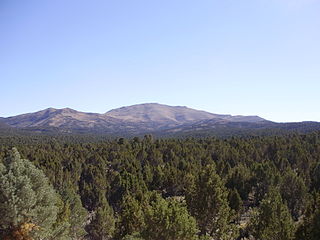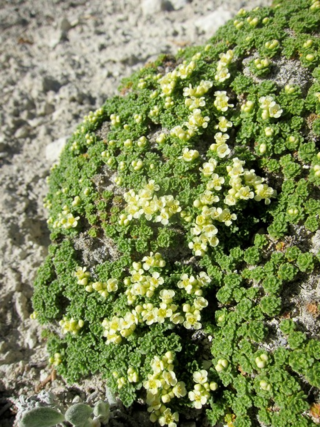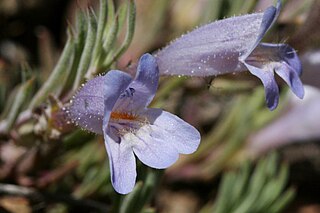
Penstemon, the beardtongues, is a large genus of roughly 280 species of flowering plants native mostly to the Nearctic, but with a few species also found in the North American portion of the Neotropics. It is the largest genus of flowering plants endemic to North America. As well as being the scientific name, penstemon is also widely used as a common name for all Penstemon species alongside beardtongues.

Penstemon strictus, the Rocky Mountain penstemon, is a penstemon with showy blue flowers.

Wislizenia refracta, common names jackass clover or spectacle fruit, is one of the three recognized species in its genus Wislizenia, which some authors consider subspecies. It is native to northwestern Mexico and the southwestern United States, particularly Chihuahua, Sonora, trans-Pecos Texas, New Mexico, Arizona, Utah, Nevada and California. The species occurs in sandy flats, desert scrub and disturbed sites such as roadsides.

Allium atrorubens is a species of wild onion known by the common name dark red onion. This plant is native to the southwestern United States where it grows in the sandy soils of the Mojave Desert, the Great Basin and higher-elevation deserts in Nevada, eastern California southwestern Utah, northwestern Arizona.
Enefit American Oil is a Utah based oil shale exploration and development company. It has been involved in the development of oil shale since 2005. Since 2011 it is a subsidiary of Eesti Energia, internationally known as Enefit.

Pinyon–juniper woodland, also spelled piñon–juniper woodland, is a biome found at higher elevations near deserts in the Western United States, characterized by being an open forest dominated by low, bushy, evergreen junipers, pinyon pines, and their associates which vary from region to region. The woodland's density and crown height varies dramatically, with mature trees ranging in height from as low as 2 meters up to 15 meters. At lower elevations, junipers often predominate and trees are spaced widely, bordering on and mingling with grassland or shrubland. As elevation increases, pinyon pines become common and trees grow closer, forming denser canopies. Historically, pinyon-juniper woodland has provided a vital source of fuel and food for peoples of the American Southwest.

Penstemon spectabilis is a species of penstemon known by the common name showy penstemon or showy beardtongue. It is native to southern California and Baja California, where it grows in the chaparral, scrub, and woodlands of the coastal mountain ranges.

Penstemon thompsoniae, Thompson's beardtongue, is a low perennial plant endemic to the southwestern United States, where it grows in dry shrublands, woodlands and forests. It is considered a species of conservation concern in California.

Physaria lepidota, the Kane County twinpod, is a plant species endemic to Utah. It is known only from Kane, Washington, and Garfield Counties in the southern part of the state. It grows on rocky slopes and outcrops, and sometimes in disturbed areas.
Phacelia cronquistiana is a plant species native to Utah and Arizona, known only from Kane and Mohave Counties. It occurs in sagebrush and Pinus ponderosa forests at elevations of 1,900–2,100 m (6,200–6,900 ft).
Caulanthus barnebyi, the Black Rock wild cabbage, is a plant species endemic to a small region in the US State of Nevada. It is known only from the Black Rock Mountains in Humboldt and Pershing Counties in the northwestern part of the state. It grows on dry, rocky slopes and outcrops at elevations of 4,300–4,900 feet (1,300–1,500 m).
Descurainia paradisa is a plant species native to eastern and northern California, southeastern Oregon, Box Elder County in northwestern Utah, and most of Nevada. It grows in shrub communities at elevations of 3,300–7,500 feet (1,000–2,300 m).

Lepidium nanum, the dwarf pepperweed, is a plant species native to the US states of Nevada and Utah. It is known from four counties in Nevada but only one in Utah. It occurs in open, sunlit areas in the desert, often with gypsum, limestone, quartzite or chalky soils.
Thelypodium laxiflorum, the droopflower thelypody, is a plant species native to the southwestern United States. It grows in open, rocky places on slopes and cliff faces, usually in pinyon-juniper woodlands at elevations of 4,900–10,200 feet (1,500–3,100 m). It has been reported from Utah, western Colorado, southern Nevada, northwestern Arizona, and northwestern New Mexico.
Allium passeyi is a plant species endemic to Box Elder County in northwestern Utah. It grows in shallow, stony locations at elevations of 1400–1600 m.

Allium brevistylum is a plant species native to the western United States. It grows in meadows and along stream banks high in the mountains of Colorado, Utah, Wyoming, Montana and Idaho, at elevations of 2200–3400 m.

The flora of the U.S. Sierra Nevada alpine zone is characterized by small, low growing, cushion and mat forming plants that can survive the harsh conditions in the high-altitude alpine zone above the timber line. These flora often occur in alpine fell-fields. The Sierra Nevada alpine zone lacks a dominant plant species that characterizes it, so may or may not be called a vegetation type. But it is found above the subalpine forest, which is the highest in a succession of recognized vegetation types at increasing elevations.

Penstemon cyanocaulis, the bluestem penstemon or bluestem beardtongue, is a perennial plant in the plantain family (Plantaginaceae) found in the Colorado Plateau and Canyonlands region of the southwestern United States.

Penstemon ambiguus, commonly known as the bush penstemon, pink plains penstemon, or gilia beardtongue is a species of Penstemon that grows in the shortgrass prairies and deserts of the western United States and northern Mexico. This bush like penstemon grows in sandy, loose, and creosote soils and is particularly known for the spectacular flowering show it produces, sometime seasons turning whole hillsides bright pink–white.

Penstemon caespitosus, commonly known as mat penstemon, is a summer blooming perennial flower in the large Penstemon genus. It is a widespread plant from near timberline to the foothills in the Southern Rocky Mountains and Colorado Plateau in North America. It is noted for its ground hugging growth habit and as a plant used in xeriscape and rock gardening.














